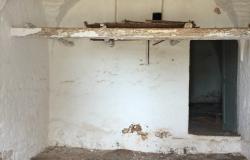Hi. Looking at the photos,…
Submitted by modicasa on Wed, 05/13/2020 - 02:40Hi. Looking at the photos, to stop the damp you would need to put in a proper aerated floor in the 1st photo, and in the second you need to sort out your external walls, pointing, gutters etc as it looks to be penetrative damp. Then youd need to take off all the plaster/cement back to the stone, and start again using modern breathable products. Its a guess based on a couple of photos though, so hardly gospel.
Hi, thanks for your reply. …
Submitted by Tabbi on Wed, 05/13/2020 - 17:21In reply to Hi. Looking at the photos,… by modicasa
Hi, thanks for your reply. Yes the 1st photo the building here is built directly onto stone substrate. I hadn't looked at aerated floors, I understand this is a system that allows the collected moisture be vented out of the building. Are you in Puglia and perhaps know any local experts in stone floor work? The second picture is an independent unit and a newer build, I suspect under the tiling there may be a concrete floor. Counting the days until I can get back there and investigate properly.
Tabbi , from the size of the…
Submitted by Ugo on Sat, 05/16/2020 - 05:29Tabbi ,
from the size of the windows, it seems to understand that the floor of the rooms could be found lower than the external level of the ground and in fact the humidity spots are placed in the lower part of the rooms - if the humidity was due to the fact that the rooms have been closed for years, the humidity would be generated by the condence and therefore the stains would also be high on the walls.
If this analysis of mine corresponds to the facts - the action to be taken is to create an interspace between the building and the ground. the two ways -
first, remove all the floor, dig at least 30 centimeters below it, place a layer of breccia with large pebbles on the bottom of the excavation, and on top of a layer of particular elements called <pots> made with baked clay (there are also articles of different agglomerate from baked clay), so that air can circulate in their thickness - create holes in the external walls, placed in communication with the state of <pignatte> so that air can circulate - Attention, the holes must be partially occluded outside, with a fine metal net, to prevent the entry of animals
second, dig a tunnel all around the building, to space the walls from the ground and also create a cavity here, similar to the one placed under the floor - in technical terms this tunnel is called <vespaio> -
Obviously this is my description, simple, and I highly recommend that you contact a surveyor, also because, for this job, you need a building license
Hi Tabbi, Damp in walls is a…
Submitted by Ronco on Mon, 05/18/2020 - 10:50Hi Tabbi,
Damp in walls is a real pain in the neck in old buildings.
I am an architect and we have found the best approach is four fold, (it is what we recommended to our client who runs a pizzeria who needed to be absolutely sure that they get rid of the rising damp and it worked) :
- If not already done – ensure that vespaio (ventilated ground floor slab) is installed. This will result in a dry ground floor but if the load bearing walls are still bedded in the damp ground – the walls will still be damp.
- Ensure that all rain water (on or under -ground) can run away from the building which may involve excavation around the perimeter, insertion of land drains etc.
- On internal and external walls remove the existing plaster and re-plaster up to 1.8m off ground floor with water resistant plaster.
- Install a "Biodry" device (or similar) in a central position in the house. This device repels water from rising. Here is the link to the non invasive treatment to cure rising damp in walls (Swiss company) https://www.biodry.eu/en/
There are other companies that provide a device like Biodry – we have had only good experience with Biodry, but happy to learn of other good companies.



